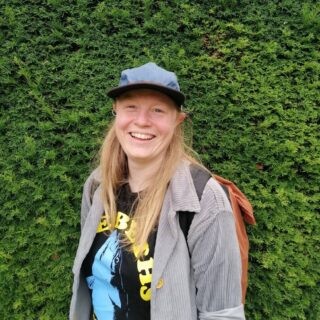
In the intricate world of honey bees, every strand of DNA tells a story – of adaptation, resilience, and survival. Few people are as skilled at deciphering those stories as Dr Victoria G. Buswell, an Ecological Bioinformatician working within the Information and Computational Sciences department. Her work bridges the realms of ecology, genetics, and computer science, using cutting-edge bioinformatics to understand the complex genetic identity of Apis mellifera mellifera – the dark European honey bee.
From Field to Data: The Journey of a Researcher
Dr Buswell’s journey into bee research began with a deep fascination for the invisible relationships that shape ecosystems. After earning a First-Class BSc in Bioscience from Canterbury Christ Church University (2013–2017), her dissertation explored an unusual detective story – tracing the DNA of the pear psylla (Cacopsylla pyricola) in the gut contents of earwigs (Forficula auricularia). This early work showcased her talent for combining ecology with molecular detective work: using DNA evidence to uncover who eats whom in the natural world.
Her next step – a NERC-funded Ph.D. at the University of Plymouth (2017–2022) – took her from orchard insects to one of the most significant pollinators on Earth. Her doctoral research, “The Phenotypic and Genomic Identity of Apis mellifera mellifera,” sought to unravel how the dark European honey bee varies across landscapes, and how its genetics can guide conservation and breeding. The project combined fieldwork, molecular biology, and powerful computational analyses – an ambitious blend that reflected both scientific rigour and a passion for protecting native bee diversity.
The Power of Data in Bee Conservation
Today, Dr Buswell’s work focuses on the analysis of amplicon and metagenomic datasets – vast collections of DNA sequences that reveal the hidden microbial and genetic worlds within and around bees. She also works with whole genome and RNA transcriptome data, providing insight into how bees respond to environmental stressors at the molecular level. Using high-performance computing, sophisticated software, and custom Python scripts, she processes, analyses, and visualises this genetic data – transforming millions of raw sequences into patterns that tell us how bees evolve, adapt, and survive.
Her bioinformatics expertise is not confined to a single dataset or discipline. It is part of a growing global effort to harness big data in service of pollinator conservation. Understanding the genomic structure of Apis mellifera mellifera is vital for guiding breeding programmes, safeguarding genetic diversity, and ensuring that conservation efforts are rooted in robust scientific evidence.
A Researcher at the Crossroads of Ecology and Technology
Dr Buswell’s career exemplifies the future of ecological research: where field ecology meets computational power. Her work demonstrates that bee conservation is no longer just about what we see in the hive or the meadow, but also about what we can read in the code of life itself.
As beekeepers and researchers continue to face challenges from disease, habitat loss, and climate change, scientists like Victoria Buswell are giving us the tools to understand and protect honey bees at their most fundamental level. Behind every buzzing colony lies a genetic story – and thanks to her work, we are learning how to read it more clearly than ever before.

[…] the focus of Victoria Buswell’s PhD research at the University of Plymouth, presented recently to the international beekeeping […]
[…] Victoria Buswell (2022): Genomic and phenotypic basis of local adaptation in the black honeybee Apis mellifera mellifera. […]